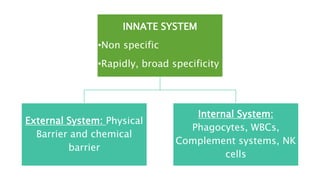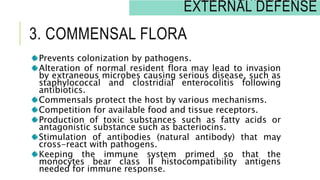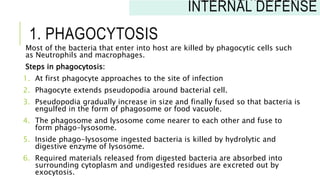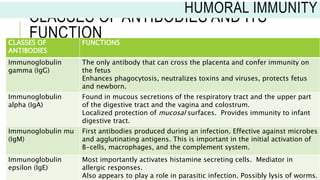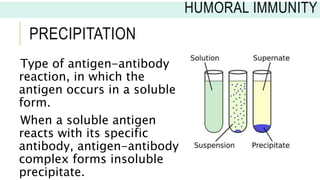TOPIC 1 INTRODUCTION TO IMMUNOLOGY.pptx
- 1. TOPIC 1 INTRODUCTION TO IMMUNOLOGY NS1122 BASIC SCIENCE 3: IMMUNOLOGY DIPLOMA IN NURSING MDM SITI BAINUN BINTI MOHD DALI
- 2. LEARNING OUTCOME At the end of this lecture, students should be able to: √ State the definition of immunology √Define the important terms related to immunology √Explain the categories of immune systems
- 3. 1. IMMUNOLOGY AND ITS TERMINOLOGY
- 4. WHAT IS IMMUNOLOGY? Immunology is the study of physiology mechanisms that humans and other animals use to defend their bodies from invading organisms. Example of invading organisms: bacteria, fungi, viruses, fungi, parasites, and toxins
- 5. In other words, immunology is the study on how our body’s mechanism: 1.Protect against infectious disease 2.Distinguish self from non-self component 3.Eliminate damages/malignant cells and non-self component
- 6. 2. CLASSIFICATION OF IMMUNE RESPONSE
- 7. 2.1 IMMUNE SYSTEM Immune system is typically associated with defending against foreign intruders, called pathogen. The immune system protects us from infection through various lines of defense If the immune system is not functioning as it should, it can result in various diseases, such as autoimmune, allergy, cancer and etc.
- 8. 2.2 CATEGORIES OF IMMUNE SYSTEM The immune system has been divided into: 1.Innate immunity 2.Adaptive immunity /acquired immunity
- 9. IMMUNE SYSTEM INNATE SYSTEM •Non specific •Rapidly, broad specificity External System: Physical Barrier and chemical barrier Internal System: phagocytes, WBCs, Complement systems, NK cells ACQUIRED SYSTEM Specific Works slowly, antigen- specific Basis Of Effector Molecules Humoral: mediated by B- cells and produces antibodies Cell Mediated: mediated by T-cells Basis of Mode of Development Active: produce their own antibodies Passive: receives antibody from external
- 11. INNATE SYSTEM •Non specific •Rapidly, broad specificity External System: Physical Barrier and chemical barrier Internal System: Phagocytes, WBCs, Complement systems, NK cells
- 12. 2.2.1 INNATE IMMUNITY They are also referred as “non-specific immunity” Innate immunity is the body first line of defense against pathogen uses mostly physical and chemical barriers. Works rapidly (within minutes) and has broad specificity.
- 13. CLASSIFICATION OF INNATE IMMUNITY Can be further divided into two: i. External Defense (first line defense): include physical barriers (skin, mucus, nasal hair, cilia) and chemical barriers (oil and sweat, stomach acid, cerumen, lysosome in tears and tissue fluid, vaginal bacteria producing lactic acid.) ii. Internal defense(second line defense): phagocytes (macrophages) and WBCs (neutrophils and monocytes), inflammatory reactions, interferons, complement system, fever, Natural Killer Cells (NK cells)
- 14. INNATE IMMUNITY: MECHANISM OF EXTERNAL DEFENSE 1. Physical barriers (skin and mucous membrane) 2. Chemical factors (antimicrobial substances) 3. Commensal flora
- 15. Intact skin is impenetrable to most of the bacteria. Its low pH and presence of fatty acid makes the environment inhospitable for bacteria other than commensals. The continual shedding of the squamous epithelium also reduces the bacterial load. Mucus membranes- form less formidable barrier. The mucus with entrapped bacteria is swept away by cilia of the ciliated respiratory mucosa or the villi in the intestine. Particles are swallowed and coughed out by cough reflex. 1. PHYSICAL BARRIERS (SKIN AND MUCOUS MEMBRANE) INNATE IMMUNITY: EXTERNAL DEFENSE
- 16. i). Skin has two Layers: Epidermis: Thin outer layer of epithelial tissue. Contains Langerhans cells, dead cells, and keratin (waterproof). Dermis: Thick inner layer of connective tissue. Infections are rare in intact skin. Exceptions: i. Hookworms can penetrate intact skin ii. Dermatophytes: “Skin loving” fungi 1. PHYSICAL BARRIERS (SKIN AND MUCOUS MEMBRANE) INNATE IMMUNITY: EXTERNAL DEFENSE
- 17. Intact Skin is an Effective Barrier Against Most Pathogens INNATE IMMUNITY: EXTERNAL DEFENSE
- 18. 2. CHEMICAL FACTORS (ANTIMICROBIAL SUBSTANCES) The barrier defense of skin and mucus membrane are reinforced by the presence of antibacterial substances. Lysozyme, an enzyme present in most secretions degrade bacterial peptidoglycan. In acute phase of infection, pathogens ingested by macrophages stimulate the synthesis and secretion of several cytokines. Cytokines such as interleukin-1 and interleukin-6 travel through the blood and cause the liver to synthesize and secrete acute phase proteins into the blood. INNATE IMMUNITY: EXTERNAL DEFENSE
- 19. 3. COMMENSAL FLORA Prevents colonization by pathogens. Alteration of normal resident flora may lead to invasion by extraneous microbes causing serious disease, such as staphylococcal and clostridial enterocolitis following antibiotics. Commensals protect the host by various mechanisms. Competition for available food and tissue receptors. Production of toxic substances such as fatty acids or antagonistic substance such as bacteriocins. Stimulation of antibodies (natural antibody) that may cross-react with pathogens. Keeping the immune system primed so that the monocytes bear class II histocompatibility antigens needed for immune response. INNATE IMMUNITY: EXTERNAL DEFENSE
- 20. INNATE IMMUNITY: MECHANISM OF INTERNAL DEFENSE 1. Phagocytes (macrophages) 2. Inflammatory reactions 3. Interferons 4. Complement system 5. Natural Killer Cells (NK cells)
- 21. 1. PHAGOCYTOSIS Most of the bacteria that enter into host are killed by phagocytic cells such as Neutrophils and macrophages. Steps in phagocytosis: 1. At first phagocyte approaches to the site of infection 2. Phagocyte extends pseudopodia around bacterial cell. 3. Pseudopodia gradually increase in size and finally fused so that bacteria is engulfed in the form of phagosome or food vacuole. 4. The phagosome and lysosome come nearer to each other and fuse to form phago-lysosome. 5. Inside phago-lysosome ingested bacteria is killed by hydrolytic and digestive enzyme of lysosome. 6. Required materials released from digested bacteria are absorbed into surrounding cytoplasm and undigested residues are excreted out by exocytosis. INNATE IMMUNITY: INTERNAL DEFENSE
- 23. 2. INFLAMMATION Inflammation is an important defense mechanism of host to prevent infection. It is induced in response to tissue damage caused by microorganism, toxins or by mechanical means. The inflammation may be acute; for eg. in response to tissue damage or chromic; for eg. Arthritis, cancer etc. Main aim of inflammation is to prevent spread of injected microorganism or toxin from site of injection and kill them on spot by phagocytosis. INNATE IMMUNITY: INTERNAL DEFENSE
- 24. Steps in inflammation response: 1. Damaged tissue releases histamine. Histamine will stimulate an immediate inflammatory response. 2. Histamine will: 1. cause the blood capillaries to expand for more blood to flow to the infected area 2. Increase permeability of blood capillaries to phagocytosis. The phagocytes and clotting factors will accumulate in the infected area. 3. The blood clotting mechanism is triggered 4. The phagocytes carry out phagocytosis INNATE IMMUNITY: INTERNAL DEFENSE
- 26. CHARACTERISTICS OF INFLAMMATION: i. Redness ii. Swelling iii.Heat iv.Pain v. Loss of function INNATE IMMUNITY: INTERNAL DEFENSE
- 27. 3. INTERFERON (INF) Interferons are set of glycoproteins which are released by the cells that infected by virus in vivo and which reacts with uninfected cells so as to make them resistant to infection to virus by blocking viral mRNA transcription. There are THREE (3) types of interferons: INNATE IMMUNITY: INTERNAL DEFENSE
- 28. 4. COMPLEMENT SYSTEM A series of 11 proteins that are activated by antigen- antibody complexes. Activation of the complement increases phagocytosis and destruction of the microbial organisms that enter the body of an individual. The system perform function in different ways: 1. Complement proteins ruptures the cell membranes of microbes 2. Stimulates mast cells to produce histamine 3. Strengthens the inflammatory reaction 4. Act as chemokines 5. Attract phagocytes to the infected area. INNATE IMMUNITY: INTERNAL DEFENSE
- 29. 5. NATURAL KILLER CELLS (NK CELLS) These are one of the type of lymphocytes The cells lyses the viral infected body cells and abnormal cells which could form tumours. INNATE IMMUNITY: INTERNAL DEFENSE
- 31. 2.2.2 ACQUIRED IMMUNE SYSTEM They are also referred as “specific immunity” It is third line of defense Adaptive immune system works slowly (starts in days) and more complex that the innate Adaptive immunity involves antigen-specific immune response. Meaning that the immune system recognizes, attacks, destroys, and remembers (memory) each pathogen that enters the body. It does this by making specialized cells and antibodies that render the pathogens harmless. For each type of pathogen, the immune system produces cells that are specific for that particular pathogen.
- 32. CLASSIFICATION OF ACQUIRED IMMUNITY ACQUIRED SYSTEM Specific Works slowly, antigen- specific Basis Of Effector Molecules Humoral: mediated by B- cells and produces antibodies Cell Mediated: mediated by T-cells Basis of Mode of Development Active: produce their own antibodies Passive: receives antibody from external
- 33. 2.2.2.1 BASIS OF EFFECTOR MOLECULES
- 34. HUMORAL IMMUNITY immunity that is mediated by antibodies (B cells). promotes the development of normal operation antibodies Antibodies production: 1. Antibodies produced by B-lymphocytes and plasma cells in lymphoid organs and bone marrow 2. derived from long-lived antibody-producing plasma cells generated by previous antigen exposure and, in secondary immune response, by the activation of memory B cells. HUMORAL IMMUNITY
- 35. CLASSES OF ANTIBODIES AND ITS FUNCTION CLASSES OF ANTIBODIES FUNCTIONS Immunoglobulin gamma (IgG) The only antibody that can cross the placenta and confer immunity on the fetus Enhances phagocytosis, neutralizes toxins and viruses, protects fetus and newborn. Immunoglobulin alpha (IgA) Found in mucous secretions of the respiratory tract and the upper part of the digestive tract and the vagina and colostrum. Localized protection of mucosal surfaces. Provides immunity to infant digestive tract. Immunoglobulin mu (IgM) First antibodies produced during an infection. Effective against microbes and agglutinating antigens. This is important in the initial activation of B-cells, macrophages, and the complement system. Immunoglobulin epsilon (IgE) Most importantly activates histamine secreting cells. Mediator in allergic responses. Also appears to play a role in parasitic infection. Possibly lysis of worms. HUMORAL IMMUNITY
- 36. DEFENSIVE MECHANISM BY ANTIBODIES Antibodies do not destroy antigens, they inactivate and tag antigens for destruction. 1. Neutralization 2. Opsonization 3. Agglutination 4. Precipitation 5. Antibody-dependant cellular cytotoxic 6. Complement fixation HUMORAL IMMUNITY
- 37. NEUTRALIZATION Antibodies bind to and blocks specific sites on viruses and bacteria, thus preventing these antigens from binding to receptors on tissue cells Later destroyed by phagocytes HUMORAL IMMUNITY
- 38. AGGLUTINATION Antibodies bind the same determinant on more than one antigen Makes antigen-antibody complexes that are crosslinked into large lattices (agglutination) IgMs are good at this with mismatched blood. HUMORAL IMMUNITY
- 39. PRECIPITATION Type of antigen-antibody reaction, in which the antigen occurs in a soluble form. When a soluble antigen reacts with its specific antibody, antigen-antibody complex forms insoluble precipitate. HUMORAL IMMUNITY
- 40. COMPLEMENT FIXATION Main mechanism used against cellular antigens Antibodies bound to cells, change shape and expose complement binding site This triggers complement fixation on the antigenic cell surface resulting in cell lysis. HUMORAL IMMUNITY
- 41. OPSONIZATION Antibodies acts as opsonin to tag foreign pathogen for elimination by phagocytes. Opsonin are used to overcome the repellent force (negatively charged cell walls of pathogen and phagocytes) between the negative cell walls and promote uptake of the pathogen by the macrophage. HUMORAL IMMUNITY
- 42. ANTIBODY-DEPENDANT CELLULAR CYTOTOXIC NK cells and other leukocytes bind to antibody coated cells by Fc receptors and destroy these cells. Eosinophils mediate a special type of ADCC directed against some helminthic parasite. Helminths are too large to be engulfed by phagocytes, and their integument is relatively resistant to the microbicidal products of neutrophils and macrophages, but they can be killed by a basic protein (histamine) present in the granules of eosinophils. IgE coats the helminths, and eosinophils can then bind to the IgE. HUMORAL IMMUNITY
- 43. HUMORAL IMMUNITY
- 44. CELL MEDIATED IMMUNITY CI composed of T-lymphocytes Immune response in which body develops large number of lymphocytes that are specifically activated against foreign agent. These activated lymphocytes have the ability to attach to a foreign agent and destroy it. Acts in the case of intracellular pathogens, antibodies are ineffective because of their CELL MEDIATED IMMUNITY
- 46. TYPES OF EFFECTOR T CELLS 1. Regulatory T cells a) T-helper cells: Interacts only with antigen-MHC II complex Potentiate both engulfment and killing by phagocytosis promote growth and differentiation of cells at the immune response site. Stimulate B cells to produce antibodies. b) T-regulatory (suppressor cells) suppress the activity of B cells and other T cells. inhibit antibody production by B cells, suppress the functions of the killer T cells and helper T cells. CELL MEDIATED IMMUNITY
- 47. TYPES OF EFFECTOR T CELLS 2. Cytotoxic (killer) T cells: CD8+ Interacts with antigen-MHC-I molecule Actions mediated by cytokines activation of cytotoxic T cells lead to the destruction of virus infected cells, tumor cells or foreign cells. CELL MEDIATED IMMUNITY
- 48. 2.2.2.2 BASIS OF MODE OF DEVELOPMENT
- 50. BASIS OF MODE OF DEVELOPMENT 1. ACTIVE IMMUNITY: lymphocytes produce their own antibodies as a response to stimulation by the antigen. i. Artificial active immunity: provided by vaccination ii. Natural active immunity: provided by natural infection
- 51. BASIS OF MODE OF DEVELOPMENT 2. PASSIVE IMMUNITY: the body receives antibodies from an external sources i. Natural passive immunity: IgG antibody produced in mother cross placenta and protects fetus up to 6mo age. And transfer of maternal antibodies through milk ii. Artificial passive immunity: preformed antibody are injected into host for immunity. Eg: anti-venom, Rabies vaccine
- 52. Broad range Highly specific Humoral Cellular
- 53. CHARACTERISTICS/ DIFFERENCES OF INNATE AND ADAPTIVE IMMUNITY INNATE IMMUNITY ADAPTIVE IMMUNITY Antigen independent Antigen dependent No time lag A lag period Not antigen specific Antigen specific No immunologic memory Development of memory Cells involved: - Neutrophils (PMN) - Macrophages - Natural killer (NK) cells Cells involved : - T lymphocytes - B lymphocytes - Dendritic cells - Eosinophils - Basophils/mast cells
- 55. CHRONOLOGY OF THE IMMUNE RESPONSE Bactericidal molecules Phagocytes, Soluble mediators Antigen presentation, B and T cell maturation
- 56. THANK YOU!
Editor's Notes
- In vivo: process taking placed in living organisms
- Chemokines: class of cytokines with functions that include attracting white blood cells to sites of infe










